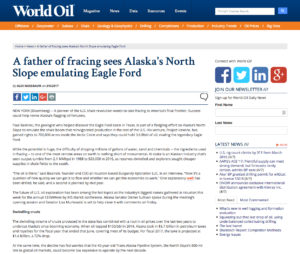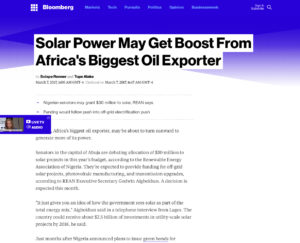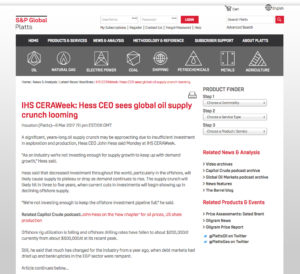A Shale Boom For Alaska’s North Slope? 03/09/17 •lweb.es/f2710 •bit.ly/2pfiu0G
 A pioneer of the U.S. shale revolution, Paul Basinski, wants to take fracking to America’s final frontier – Alaska.
A pioneer of the U.S. shale revolution, Paul Basinski, wants to take fracking to America’s final frontier – Alaska.
Five of the largest publicly traded oil companies – BP, Chevron, Exxon Mobil, Royal Dutch Shell, and Total – are trying to work down debts that totaled $297 billion at the end of December. “For the entire oil and gas industry, balance sheets have never been worse,” said Fadel Gheit from Oppenheimer & Co. The industry is betting that prices will maintain a delicate balance – high enough to repair balance sheets and finance new projects, but not so high that it creates a new glut.
DetailsIndia, the world’s third-largest oil consumer, will conduct auctions of oil and gas blocks under the Open Acreage Licensing Policy twice a year with the first round being held in July. OALP will differ from the current licensing policy whereby the government identifies the oil and gas blocks and then puts them on auction. This policy gives an option to a company looking for exploring hydrocarbons to select the exploration areas on its own, based on the seismic and well data that the Directorate-General of Hydrocarbons has put in in a National Data Repository.
DetailsLast year the Federal Energy Regulatory Commission (FERC) certificated 17.6 billion cubic feet per day of new natural gas pipeline capacity, and so far this year the Commission has certificated more than 7 Billion cubic feet per day. The seven projects certificated during the first few weeks of 2017 include more than 1,500 miles of natural gas pipeline construction and expansions. The pipeline projects are concentrated in the eastern half of the United States to improve access to markets for growing eastern natural gas production, and they have projected 2017 and 2018 in-service dates.
Details Nigeria is debating the allocation of $30 million to solar projects in this year’s budget with funding expected for off-grid solar projects, photovoltaic manufacturing, and transmission upgrades.
Nigeria is debating the allocation of $30 million to solar projects in this year’s budget with funding expected for off-grid solar projects, photovoltaic manufacturing, and transmission upgrades.
“The prospect of deepening Myanmar-India ties are very interesting and could potentially be quite wide,” said Michal Meidan, Asia Energy Policy Analyst at Energy Aspects. “Indian refiners are increasingly looking to sell products to Myanmar in order to tap a growing market. This makes sense both on the geopolitical level where India is increasingly seeking regional influence – and Myanmar will be pleased to hedge against China, and in terms of Indian refiners’ corporate needs to deepen their presence in new markets,” she added.
Details73 million acres offshore Texas, Louisiana, Mississippi, Alabama, and Florida will be offered for oil and gas exploration and development. The proposed lease sale scheduled for August this year would include all available unleased areas in federal waters of the Gulf of Mexico, and is part of President Trump’s plan to make the United States energy independent. The estimated amount of resources projected to be developed as a result of the proposed lease sale ranges from 0.211 to 1.118 Billion barrels of oil and from 0.547 to 4.424 Trillion cubic feet of gas.
Details A significant, years-long oil supply crunch may be approaching due to insufficient investment in exploration and production, Hess CEO John Hess said at the IHS CERAWeek, and this will begin showing up in declining offshore supply. He added that “The shale business is back in business and starting to grow again,” but such growth in US shale would not be enough to meet global oil demand, which the International Energy Agency has projected to grow between 1.4-1.6 million barrels a day over this year and the next.
A significant, years-long oil supply crunch may be approaching due to insufficient investment in exploration and production, Hess CEO John Hess said at the IHS CERAWeek, and this will begin showing up in declining offshore supply. He added that “The shale business is back in business and starting to grow again,” but such growth in US shale would not be enough to meet global oil demand, which the International Energy Agency has projected to grow between 1.4-1.6 million barrels a day over this year and the next.
Saudi Arabia has cut the pricing for some of its April oil sales to Asia, showing that it is trying to lure buyers toward its lighter and less sulfurous crude varieties. “This came as a complete surprise to the market,” said Tushar Tarun Bansal, director at Ivy Global Energy in Singapore. “This is a signal from the Saudis that they are serious about market share and pricing crude competitively, and would even be open to changing the methodology if the need arises.” This is the producer’s latest effort to defend sales in Asia.
DetailsTies between the Gulf and India stretch back several millennia. Until the last decade or so, the relationship was still being driven almost exclusively by economic interests: energy trade and migrant labor. Now, however, the agendas of rising powers like India and China are expanding, including in the Middle East. Specifically, India-Gulf Cooperation Council (GCC) ties will be among the most important relationships for both sides in the coming decades. The emergence of several factors is forcing New Delhi to consider the strategic aspects of those ties…
DetailsAccording to Rigzone’s Ideal Employer Survey the top three attributes that oil and gas professionals value most in an employer are “a commitment to health and safety”, “competitive salary” and “positive organizational culture”. With respect to the “ideal employer”, the first three rankings go to Royal Dutch Shell, Exxon Mobil and Chevron, both globally and in the Southeast Asia region. Southeast Asia has suffered with the global oil glut but it still has opportunities for growth. InvestKL, for example, is working closely with PETRONAS to help attract large global multinational oil and gas companies.
DetailsThe oil-sands operations in northern Alberta are among the costliest types of petroleum projects to develop because the raw bitumen extracted from the region must be processed and converted to a thick, synthetic crude oil. These operations have been particularly hard hit by the worst oil slump in a generation. Exxon and Conoco, for example, have removed a combined 4.65 billion barrels of oil-sands crude worth $183 billion from their books. Under U.S. Securities and Exchange Commission rules, proved reserves can only include oil and gas fields that can be produced economically within the next half decade.
Details